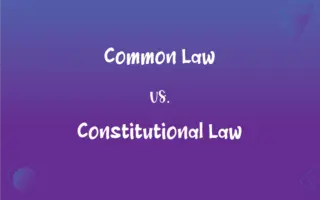Middle Ages vs. Medieval Ages: What's the Difference?
Edited by Aimie Carlson || By Janet White || Published on January 27, 2024
Middle Ages refers to a period in European history from the 5th to the late 15th century. Medieval Ages refers to another term for the Middle Ages, marking the middle period in a traditional division of European history.

Key Differences
The Middle Ages refers to a historical period in Europe stretching from the fall of the Roman Empire to the beginning of the Renaissance. Medieval Ages is an interchangeable term for the same era, emphasizing its position as the middle era between the classical civilization of Rome and the modern period.
The Middle Ages encompass various significant events, including the development of feudalism and the spread of Christianity. Similarly, the Medieval Ages highlight the same timeline, often characterized by the construction of castles, the prevalence of knightly culture, and the Crusades.
In cultural contexts, the Middle Ages are known for Gothic architecture and the early stages of vernacular literature. The Medieval Ages, under the same scope, reflect the era's unique artistic and literary styles, which were distinct from the classical antiquity and the later Renaissance.
The Middle Ages saw the rise and fall of several empires and kingdoms, shaping modern Europe's boundaries. The Medieval Ages, when looked at through a political lens, denote the same period of dynastic struggles and territorial expansions.
The Middle Ages were marked by significant social and economic changes, like the shift from slavery to serfdom. In the Medieval Ages, this period also saw the emergence of universities and a gradual transition to a more urbanized society.
ADVERTISEMENT
Comparison Chart
Terminology Usage
Often used in academic and historical discussions
Similarly used, but can be more common in popular culture
Emphasis in Context
Frequently highlights broader historical transitions
May emphasize more on cultural and social aspects
Regional Focus
Generally refers to European history
Also denotes European history, with similar geographical focus
Representation in Literature
Often depicted as a time of societal transformation
Portrayed as an era of knights, castles, and feudal systems
Perception in Modern Times
Sometimes viewed as a period of stagnation
Often romanticized for its chivalry and art
ADVERTISEMENT
Middle Ages and Medieval Ages Definitions
Middle Ages
It was a period of significant social and economic transformations.
The Middle Ages saw the emergence of the first universities in Europe.
Medieval Ages
This period is known for the development of unique cultural and artistic expressions.
Manuscript illumination was a popular art form during the Medieval Ages.
Middle Ages
The Middle Ages was a period of European history from about the 5th to the late 15th century.
The Gothic architecture of the Middle Ages is evident in many European cathedrals.
Medieval Ages
It encompasses an era of transition from ancient to modern times in European history.
The Medieval Ages were marked by the construction of impressive fortifications.
Middle Ages
This era witnessed the rise of feudalism and the spread of Christianity.
Monasteries played a key role in education during the Middle Ages.
Medieval Ages
The Medieval Ages refer to the same period as the Middle Ages, from the 5th to the late 15th century.
Chivalry was a code of conduct associated with the knights of the Medieval Ages.
Middle Ages
It was a time marked by the transition from the classical to the modern world.
The Middle Ages were crucial in shaping modern European nations.
Medieval Ages
The Medieval Ages saw significant advancements in areas like architecture and literature.
The code of chivalry in the Medieval Ages influenced literature and ethics.
Middle Ages
The Middle Ages is often characterized by its unique artistic and literary styles.
Knights and castles are iconic symbols of the Middle Ages.
Medieval Ages
It was a time of dynamic changes in society and economy.
The feudal system was a defining feature of the social structure in the Medieval Ages.
FAQs
What is significant about the Middle Ages in terms of religion?
It saw the spread and establishment of Christianity in Europe.
When did the Middle Ages occur?
From the 5th to the late 15th century.
Did the Medieval Ages have a distinctive art style?
Yes, including Gothic architecture and illuminated manuscripts.
Were there any significant technological advancements in the Middle Ages?
Yes, such as improvements in agriculture and warfare.
Did the Middle Ages experience any major conflicts?
Yes, including the Crusades and various internal wars.
Are the Middle Ages and Medieval Ages the same?
Yes, they refer to the same historical period in Europe.
What were the key social structures in the Middle Ages?
Feudalism and the manorial system were predominant.
How is the Middle Ages depicted in literature?
Often as a time of knights, castles, and religious quests.
What languages were spoken during the Medieval Ages?
Latin, along with various vernacular languages, was widely used.
What was the economic basis of the Medieval Ages?
Primarily agrarian, with emerging trade and commerce.
How did the Medieval Ages end?
Transitioning into the Renaissance marked its end.
What were the living conditions like during the Middle Ages?
Varied greatly between peasants, clergy, and nobility.
How did the Medieval Ages influence modern Europe?
They set the foundations for modern European nations and cultures.
What role did the church play in the Medieval Ages?
It was a dominant cultural, educational, and political force.
How was law and order maintained in the Medieval Ages?
Through feudal lords, local courts, and the church.
Were women influential during the Middle Ages?
They had roles but were generally limited by societal norms.
Were there any notable figures from the Middle Ages?
Yes, including Charlemagne, Thomas Aquinas, and Geoffrey Chaucer.
Did the Middle Ages see any cultural exchanges?
Yes, especially through trade routes and the Crusades.
Did the Medieval Ages contribute to scientific knowledge?
Yes, though much was influenced by religious and philosophical thought.
Was education common in the Middle Ages?
It was limited, mostly available to the clergy and nobility.
About Author
Written by
Janet WhiteJanet White has been an esteemed writer and blogger for Difference Wiki. Holding a Master's degree in Science and Medical Journalism from the prestigious Boston University, she has consistently demonstrated her expertise and passion for her field. When she's not immersed in her work, Janet relishes her time exercising, delving into a good book, and cherishing moments with friends and family.
Edited by
Aimie CarlsonAimie Carlson, holding a master's degree in English literature, is a fervent English language enthusiast. She lends her writing talents to Difference Wiki, a prominent website that specializes in comparisons, offering readers insightful analyses that both captivate and inform.






































































